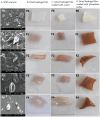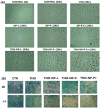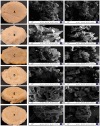Hydrogels with Essential Oils: Recent Advances in Designs and Applications
- PMID: 39451288
- PMCID: PMC11508064
- DOI: 10.3390/gels10100636
Hydrogels with Essential Oils: Recent Advances in Designs and Applications
Abstract
The innovative fusion of essential oils with hydrogel engineering offers an optimistic perspective for the design and development of next-generation materials incorporating natural bioactive compounds. This review provides a comprehensive overview of the latest advances in the use of hydrogels containing essential oils for biomedical, dental, cosmetic, food, food packaging, and restoration of cultural heritage applications. Polymeric sources, methods of obtaining, cross-linking techniques, and functional properties of hydrogels are discussed. The unique characteristics of polymer hydrogels containing bioactive agents are highlighted. These include biocompatibility, nontoxicity, effective antibacterial activity, control of the sustained and prolonged release of active substances, optimal porosity, and outstanding cytocompatibility. Additionally, the specific characteristics and distinctive properties of essential oils are explored, along with their extraction and encapsulation methods. The advantages and disadvantages of these methods are also discussed. We have considered limitations due to volatility, solubility, environmental factors, and stability. The importance of loading essential oils in hydrogels, their stability, and biological activity is analyzed. This review highlights through an in-depth analysis, the recent innovations, challenges, and future prospects of hydrogels encapsulated with essential oils and their potential for multiple applications including biomedicine, dentistry, cosmetics, food, food packaging, and cultural heritage conservation.
Keywords: active food packaging; biomedical applications; cosmetics; dentistry; encapsulation; essential oils; hydrogels; restoration of cultural heritage.
Conflict of interest statement
The author declares no conflicts of interest.
Figures













Similar articles
-
Advances in bioactive glass-containing injectable hydrogel biomaterials for tissue regeneration.Acta Biomater. 2021 Dec;136:1-36. doi: 10.1016/j.actbio.2021.09.034. Epub 2021 Sep 23. Acta Biomater. 2021. PMID: 34562661 Review.
-
State-of-the-Art Insights and Potential Applications of Cellulose-Based Hydrogels in Food Packaging: Advances towards Sustainable Trends.Gels. 2023 May 24;9(6):433. doi: 10.3390/gels9060433. Gels. 2023. PMID: 37367104 Free PMC article. Review.
-
Encapsulation of Essential Oils via Nanoprecipitation Process: Overview, Progress, Challenges and Prospects.Pharmaceutics. 2020 May 7;12(5):431. doi: 10.3390/pharmaceutics12050431. Pharmaceutics. 2020. PMID: 32392726 Free PMC article. Review.
-
Recent advances in the structure, synthesis, and applications of natural polymeric hydrogels.Crit Rev Food Sci Nutr. 2022;62(14):3817-3832. doi: 10.1080/10408398.2020.1870034. Epub 2021 Jan 6. Crit Rev Food Sci Nutr. 2022. PMID: 33406881
-
Prospects of Polymeric Nanofibers Loaded with Essential Oils for Biomedical and Food-Packaging Applications.Int J Mol Sci. 2021 Apr 13;22(8):4017. doi: 10.3390/ijms22084017. Int J Mol Sci. 2021. PMID: 33924640 Free PMC article. Review.
Cited by
-
Synthesis and Characterization of a Superabsorbent Polymer Gel Using a Simultaneous Irradiation Technique on Corn Straw.Gels. 2025 Mar 26;11(4):244. doi: 10.3390/gels11040244. Gels. 2025. PMID: 40277681 Free PMC article.
-
Enhancement of Water Uptake in Composite Superabsorbents Based on Carboxymethyl Cellulose Through Porogen Incorporation and Lyophilization.Gels. 2024 Dec 5;10(12):797. doi: 10.3390/gels10120797. Gels. 2024. PMID: 39727554 Free PMC article.
-
Designing Gel-Inspired Food-Grade O/W Pickering Emulsions with Bacterial Nanocellulose-Chitosan Complexes.Gels. 2025 Jul 24;11(8):577. doi: 10.3390/gels11080577. Gels. 2025. PMID: 40868708 Free PMC article.
-
Eco-Friendly Conductive Hydrogels: Towards Green Wearable Electronics.Gels. 2025 Mar 21;11(4):220. doi: 10.3390/gels11040220. Gels. 2025. PMID: 40277656 Free PMC article. Review.
-
Nanoemulsion Hydrogel Delivery System of Hypericum perforatum L.: In Silico Design, In Vitro Antimicrobial-Toxicological Profiling, and In Vivo Wound-Healing Evaluation.Gels. 2025 Jun 3;11(6):431. doi: 10.3390/gels11060431. Gels. 2025. PMID: 40558730 Free PMC article.
References
-
- Unalan I., Boccaccini A.R. Essential oils in biomedical applications: Recent progress and future opportunities. Curr. Opin. Biomed. Eng. 2021;17:100261. doi: 10.1016/j.cobme.2021.100261. - DOI
-
- Yan M.-R., Wang C.-H., Cruz Flores N.H., Su Y.-Y. Targeting Open Market with Strategic Business Innovations: A Case Study of Growth Dynamics in Essential Oil and Aromatherapy Industry. J. Open Innov. Technol. Mark. Complex. 2019;5:7. doi: 10.3390/joitmc5010007. - DOI
Publication types
LinkOut - more resources
Full Text Sources

